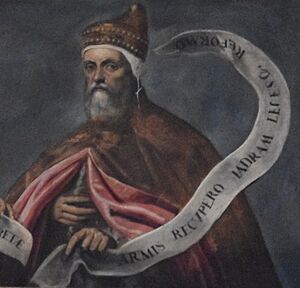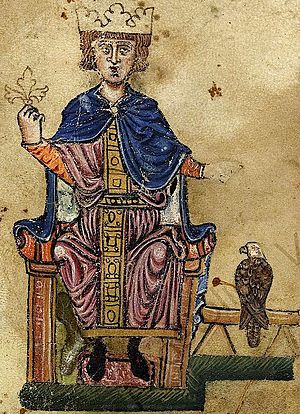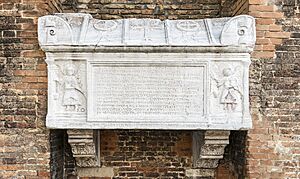Jacopo Tiepolo facts for kids
Quick facts for kids
Jacopo Tiepolo
|
|
|---|---|

Portrait by Domenico Tintoretto, late-16th-century
|
|
| Doge of Venice | |
| In office 1229–1249 |
|
| Preceded by | Pietro Ziani |
| Succeeded by | Marino Morosini |
| Podestà of Constantinople | |
In office
|
|
| Duke of Crete | |
| In office 1209–1214 |
|
| Personal details | |
| Born | shortly before 1170 Venice, Republic of Venice |
| Died | (aged c. 79) Venice, Republic of Venice |
| Spouses |
Maria Storlato
(died 1240)Valdrada of Sicily
(m. 1242–1249) |
Jacopo Tiepolo (born around 1170 – July 19, 1249), also known as Giacomo Tiepolo, was the leader of Venice (called the Doge of Venice) from 1229 to 1249. Before becoming Doge, he held important roles. He was the first Venetian Duke of Crete and served twice as the Podestà of Constantinople. He also governed Treviso twice and was an ambassador to the Pope three times. During his time as Doge, he made big changes to Venice's laws and government. However, he also faced a growing conflict with Emperor Frederick II, which turned into a war from 1237 to 1245.
Contents
Early Life and Career
Jacopo Tiepolo was the son of Pietro Tiepolo. His family was involved in trade. Jacopo himself started as a merchant around 1190. He traded with Constantinople, which was a major city at the time.
Unlike his family before him, Jacopo became very active in Venetian politics. In 1205, he helped choose Pietro Ziani as the new Doge. In 1207, he worked as a judge in Venice. Then, in 1209, he was given an important job. He became the first Duke of Crete. He held this position until 1214.
Duke of Crete: Setting Up Venetian Rule
Jacopo's main job as Duke of Crete was to set up Venice's government on the island. Venice had bought Crete from Boniface of Montferrat. Jacopo helped establish a Venetian colony there. He brought military settlers from Venice to live on the island.
In 1211, a big revolt started on Crete. The local Greek people rebelled against Venetian rule. They were helped by people from Genoa, another powerful city. Jacopo had to ask for help from Marco Sanudo, a Venetian lord. Sanudo put down the revolt. However, he didn't want to leave the island at first. It took until 1213 for Jacopo to convince Sanudo to give up his claims on Crete.
Podestà of Constantinople: A Powerful Role
Because of his experience in Crete, Jacopo was chosen for another big job in 1218. He became the Podestà of Constantinople. This meant he was Venice's main representative and governor of the Venetian community in the city. Constantinople was the capital of the Latin Empire at the time.
He stayed in this role for two years. During this time, he acted almost like an independent ruler. He made peace and trade deals for Venice. He signed agreements with the Emperor of Nicaea in 1219 and with the Sultan of Iconium in 1220. He even used a special Byzantine title, "despot." This showed how important he felt his role was.
In 1221, Jacopo was in Rome for church matters. Later that year, he became the governor (podestà) of Treviso. He signed a peace treaty there.
Jacopo went back to Rome in 1223. He got permission from the Pope for some things related to Venetian churches. After that, he returned to Constantinople. He served again as the Venetian podestà. In 1224, he made an agreement with the Latin Emperor. This deal confirmed special trade rights for Venetians. We don't know exactly when his second term ended.
In 1227, Jacopo was sent to Rome again. He also served as podestà of Treviso for a second time. He made new laws during this period. When he returned to Venice in 1228, he became a ducal councillor, advising the Doge.
Dogate: Leading Venice
Jacopo Tiepolo was elected Doge on March 6, 1229. The previous Doge had stepped down. The election was very close. Jacopo and his rival, Marino Dandolo, each got 20 votes. To break the tie, they drew lots. Jacopo won.
This close election caused a rivalry between the Dandolo family and the Tiepolo family. The Dandolos were an old noble family. The Tiepolos were seen as "new rich." To avoid future ties, the number of electors for Doge was increased. Before becoming Doge, Jacopo also had to sign a special promise. This promise, called a Promissione ducale, limited his powers.
Big Changes in Venice
Jacopo's time as Doge brought many important changes to Venice. He introduced new laws for trade in 1219. He also created new criminal laws in 1232. In 1242, he organized and wrote down all the civil laws in a new book.
He also made the government more open. He gave voting rights to more people, especially merchants. The Great Council of Venice became more important under his rule. He also created the Venetian Senate, a new part of the government.
Jacopo also supported religious orders. In 1234, he gave land to the Dominican and Franciscan groups. Two famous churches were built on this land: the Basilica di San Giovanni e Paolo and the Basilica di Santa Maria Gloriosa dei Frari.
Foreign Policy: Venice and the Empire
In foreign affairs, Jacopo continued Venice's goals. He protected Venice's overseas lands. He also supported the Latin Empire of Constantinople. Venice also tried to share influence with its rivals, Genoa and Pisa. He made many trade deals with other countries.
Even though Emperor Frederick II visited Venice in 1232, relations between Venice and his empire got worse. Frederick pursued his own goals in Italy without caring about Venice's interests. For example, he had close ties with the Greek Empire of Nicaea, which was an enemy of the Latin Empire.
Venice refused to help Frederick in his fight against the Pope. Instead, Venice slowly started to oppose Frederick. Venice helped appoint Venetian governors in Italian cities. They encouraged these cities to resist the Emperor.
After Frederick's victory in a battle in 1237, Venice allied with Genoa and the Pope. Jacopo's son, Pietro Tiepolo, was captured in this battle. Venice then campaigned in Italy. They captured the city of Ferrara in 1240. In the same year, Frederick II ordered Pietro Tiepolo's execution. This was in revenge for Venetian attacks. Venetian agents also tried to oppose Frederick's plans in the Kingdom of Jerusalem. In 1242, Jacopo recaptured the city of Pula.
After the capture of Pula, Jacopo married for a second time. His new wife was Valdrada of Sicily, a princess. Some people were suspicious of this marriage. They thought Jacopo wanted his children to become rulers of Sicily. At this time, many Venetian leaders were tired of Jacopo's policies. In 1245, some important Venetians were captured by Frederick II. They publicly disagreed with the Pope's decision to remove the Emperor from the church. This showed that Venice's conflict with Frederick was coming to an end.
Abdication and Death
Jacopo Tiepolo stepped down as Doge in May 1249. He then retired to his home in Venice.
He died on July 19, 1249. He was buried in the church of San Zanipolo.
Family
Jacopo Tiepolo was married twice. His first wife was Maria Storlato. They had four children:
- Lorenzo Tiepolo, who later became Doge from 1268 to 1275.
- Pietro, who was a governor of Treviso and was executed by Frederick II.
- Giovanni, who was a military leader in the war against Frederick.
- A daughter, also named Maria, who married into another important family.
His second wife was Valdrada of Sicily. They had two children. These children were young when Jacopo died. Their names are not known. Valdrada lived about three years longer than Jacopo.
Sources
- Nicol, Donald M. (1988). [Jacopo Tiepolo at Google Books Byzantium and Venice: A Study in Diplomatic and Cultural Relations]. Cambridge: Cambridge University Press. ISBN 0-521-34157-4. Jacopo Tiepolo at Google Books.
- Pozza, Marco (2019). "TIEPOLO, Giacomo" (in Italian). Dizionario Biografico degli Italiani, Volume 95: Taranto–Togni. Rome: Istituto dell'Enciclopedia Italiana. https://www.treccani.it/enciclopedia/giacomo-tiepolo_(Dizionario-Biografico).
| Political offices | ||
|---|---|---|
| Preceded by Pietro Ziani |
Doge of Venice 1229–1249 |
Succeeded by Marino Morosini |
| Preceded by Marino Storlato |
Podestà of Constantinople 1223–1224 (?) |
Unknown
Next known title holder:
Teofilo Zeno |
| Unknown
Last known title holder:
Marino Dandolo |
Podestà of Constantinople 1218–1220 |
Unknown
Next known title holder:
Marino Michiel |
| New title | Duke of Crete 1209–1214 |
Succeeded by Pietro Querini |




